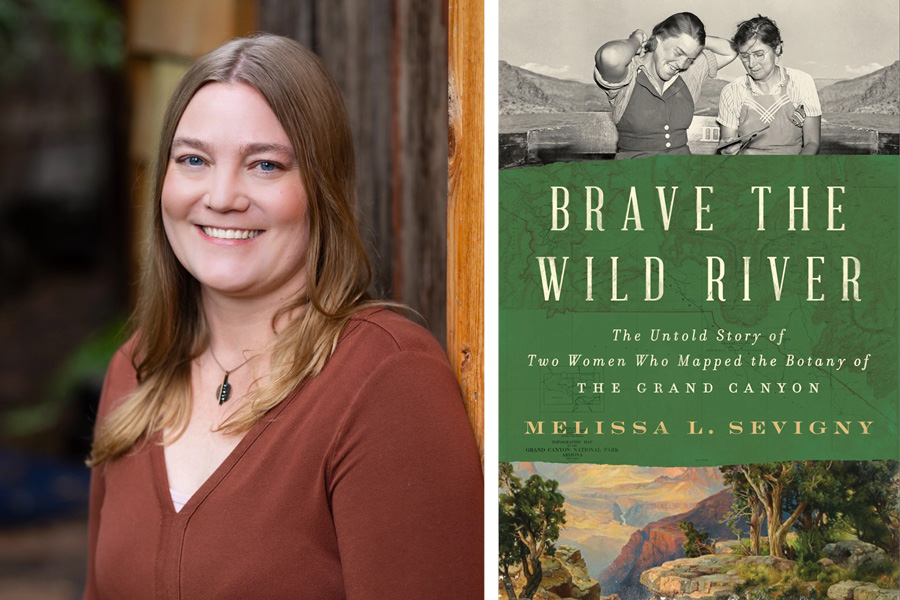Some information may be outdated.
In 2018, Melissa Sevigny was purusing Northern Arizona State University’s online archive when she stumbled across a small description that she would later turn into her newest novel: a paragraph on Louis Jotter, a botanist who had run the Grand Canyon with her mentor, Elzada Clover, in 1938.
“I was shocked I hadn’t heard their names before,” Sevigny said. So Sevigny—an award-winning science writer—started digging.
Her newest book, “Brave the Wild River: The Untold Story of Two Women Who Mapped the Botany of the Grand Canyon” follows the story of Clover and Jotter as they set off down the Colorado; Sevigny used the women’s letters and diaries to trace their 43-day journey. The trip took many twists and turns—the expedition included six people and three boats, and “there were many disasters along the way,” Sevigny said.
“Pretty much everything that could go wrong, did go wrong,” she said. “But they managed to make their plant collection.”
Sevigny will visit the Grand County Public Library on Thursday, June 1 at 7 p.m. to discuss the book. In the meantime, the Moab Sun News chatted with Sevigny about the 1938 expedition and her own writing process.
Moab Sun News: Why did you want to write about this story?
Sevigny: I’m neither a botanist nor a boater. I admit I had a lot of ground to make up in the story and I’m so grateful for all the people who helped me—I called up a lot of botanists and asked them detailed questions. I went on a rafting trip down the Grand Canyon as part of my research. That was never on my bucket list. I’m not that adventurous. But I knew I was going to have to do it to get an idea of what these women experienced.
When I started out in the sciences, my undergraduate degree was in environmental sciences at the University of Arizona. I had always wanted to be a scientist, and I ended up being a storyteller instead. I think what struck me about this story was feeling that if I had known more stories of women in science, maybe my own journey would have been different. We know that women have been doing science since science was a thing. Women have been going out and following their curiosities. For some reason we are just not telling those stories.
That’s what pulled me into writing this book: I found it inspiring that women have always been chasing their scientific dreams, especially at a time when they were being told they shouldn’t be doing this. They ignored all that and did it anyway.
Moab Sun News: How does it feel to read and recreate the adventures of these two women? What was your process like to write from first-hand pieces of evidence?
Sevigny: I was lucky to have detailed diaries that they kept during the trip, and they also both wrote letters home to friends and family—I really got to know them through their works, and that’s really the heart of their story. I used other references from other expedition members that kept diaries too.
There was also video footage Elzada took, plus a radio interview that they gave at the South Rim of the Grand Canyon. There was a rich treasure trove of material that I was very lucky to tap into—I’m grateful that they had the foresight to save that material. Louis in particular was a packrat: She saved everything that had to do with this expedition. She donated most of it to the Northern Arizona State University library before she died and her son donated the rest after her death.
I’m glad she had the foresight to see that this was significant, even as everyone else was saying it wasn’t. They had the courage to say this expedition mattered, and the botany mattered.
Moab Sun News: What did you find most surprising during your research?
Sevigny: I was actually surprised at my response to the sexism they faced in the 1930s. I knew going into this it was going to be part of the story. Not very many women got PhDs, let alone in a science field.
And hardly any women had attempted this trip. It was common thinking that women shouldn’t attempt to run the Colorado River—Louis and Elzada knew they were going to be facing that, but what I wasn’t expecting was how familiar it felt. A lot of what they were facing is still happening to women who go into spaces dominated by men. I wrote a lot more about sexism than I had intended—I really wanted it to be about science and adventure—but I tried to be unflinching about their experience and what they had to do to chase their dream.
Moab Sun News: What’s next for you? How do you hope people respond to the book?
Sevigny: It’s hard to know what to do on Saturdays, which is when I would write. It feels surreal. I hope people pick up this book and see that these are two interesting people with fascinating personalities and that the science they conducted is important and is still being used today. I hope they see it as a great adventure story—these women hit every disaster and they just kept going. If you’ve never had a chance to go see the Grand Canyon, this would be a great way to feel what it’s like to do that.
This interview has been edited for length and clarity.
Appreciate the coverage? Help keep local news alive.
Chip in to support the Moab Sun News.





